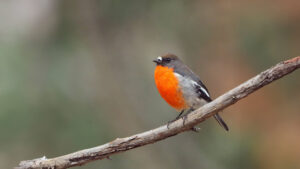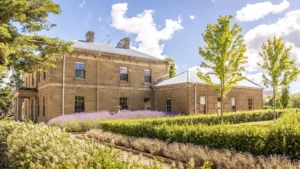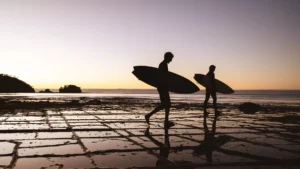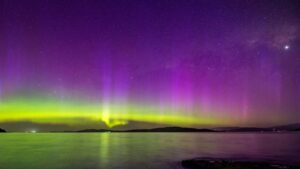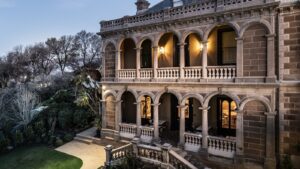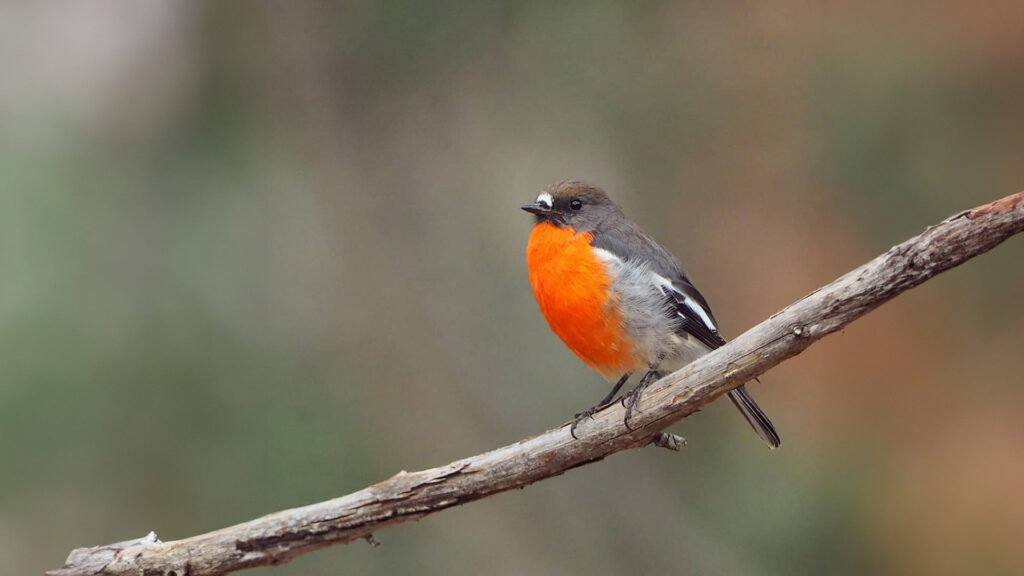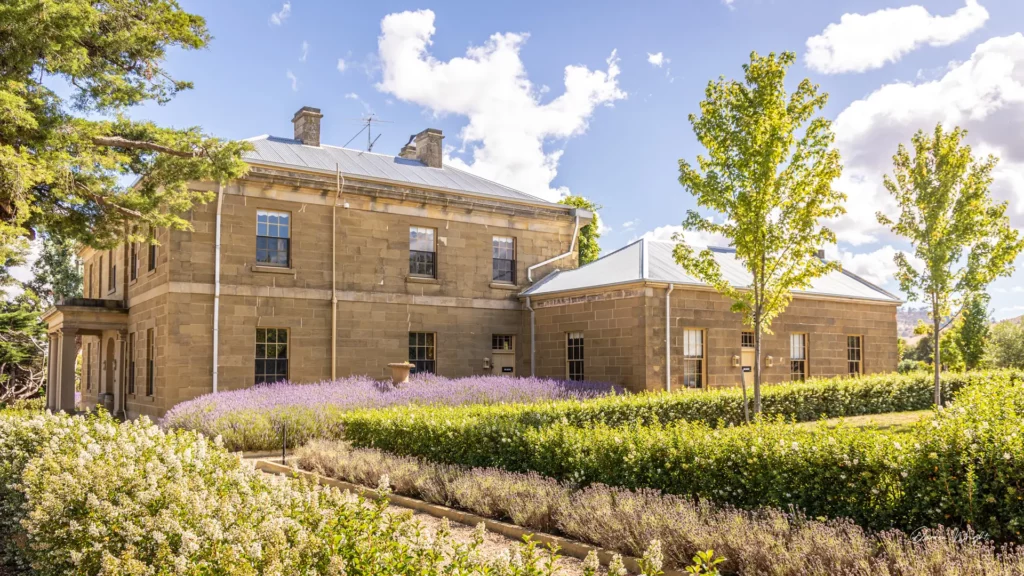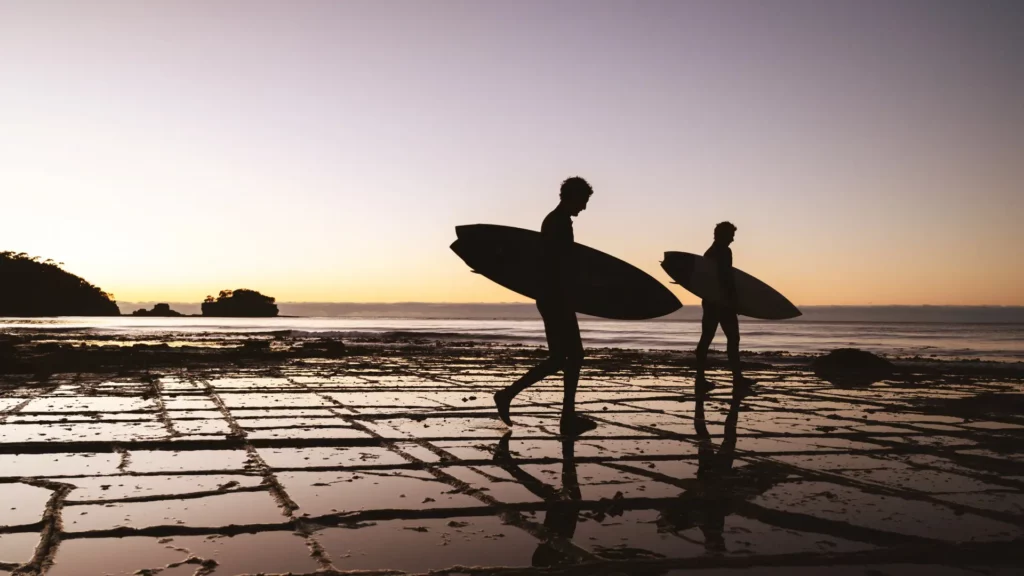Mother Nature certainly is spectacular, and in southern Tasmania, you’ll see some of her finest achievements.
From staggering sea cliffs to rugged mountain ranges and cascading waterfalls, southern Tasmania is blessed with natural wonders. Whether you are a photographer, hiker, nature lover, or just someone looking for a little time in the wild, you’re bound to fall in love with southern Tassie’s natural beauty. Short on time? We’ve compiled this list of some top must-see natural wonders to explore on your next visit to Hobart and beyond!
1. Tessellated Pavement
Upon visiting the Tessellated Pavement, you’d be fooled into thinking it was man-made. However, the natural phenomenon is caused by a movement in the earth, causing fractures. The saltwater then sits in these fractions and, over thousands of years, erodes the rock away. The pavement takes two forms: the’ loaf’- like block formations rising from the rock and the pan formation. The pan effect occurs when saltwater wears away the rock forming little depressions or pools in the rocks. The loaf effect occurs when the edges of the rock have worn away creating what looks like a loaf of bread.
The Tessellated Pavement is particularly impressive at sunrise when the colourful skies light up the small pools in the rocks.
2. Bruny Island Neck
The Bruny Island Neck is a thin piece of land formed between two bays (otherwise known as an isthmus) that connects the north and south sections of Bruny Island. Visitors can enjoy incredible panoramic views of the neck and bays via the Neck Lookout, perched atop a large dune. The Neck is also an important habitat for Bruny’s native wildlife; boardwalks have been constructed to allow visitors to view the wildlife without disturbing it.
3. Remarkable Cave
They don’t call it the Remarkable Cave for no reason. Found on the Tasman Peninsula, the Remarkable Cave has two ocean-facing entrances caused by erosion over the years. After descending into the sea cave you will be surrounded by sandstone cliffs with views through the caves and out to the beach beyond – quite a remarkable view.
Access to the cave is via a well-constructed staircase and takes around 10 minutes to return, to walk.
4. Cape Raoul, Cape Pillar & Cape Hauy
The spectacular Tasman Peninsula is home to some of the tallest sea cliffs in the Southern Hemisphere, rising 300 metres above the water. Here, you will also find some of Australia’s finest coastal walking tracks that take in the incredible coastline. The Three Cape Track is a four-day hike that takes in Cape Hauy and Cape Pillar and is one of the most spectacular walking trails in Australia. Cape Pillar and Cape Hauy can also be completed separately via the designated trails. Cape Raoul is accessible via a separate 14km trail and takes around 5 hours to complete. Each of the three capes takes you up close to the massive sea cliffs and offers spectacular coastline views. Each walk is quite unique, and we recommend you take the time to walk each of them.
5. kunanyi/Mount Wellington
The jewel in nipaluna/Hobart’s crown, kunanyi/Mount Wellington , is an amazing natural wonder accessible to all. ‘The Mountain’ (as the locals fondly call it) offers visitors and locals a wonderful array of walking tracks, mountain bike trails and waterfalls all within a short distance of nipaluna/Hobart’s CBD. It also offers incredible views of southern Tasmania and across to the east coast of Tasmania from the pinnacle. If you can brave an early morning, watching the sunrise from the summit of kunanyi/Mount Wellington is an incredible experience and one you’re unlikely to forget. Make sure you dress appropriately for your visit up the mountain as it can be very chilly!
6. Hastings Cave & Thermal Springs
The magical underground world of Hastings Cave is a must-see when travelling around southern Tasmania. Visitors can discover dolomite caves and the interesting critters that reside there. On exploring the system visitors will discover Newdegate Cave, Australia’s largest dolomite tourist cave, whose chambers have been forming over millions of years. Above ground and visitors can enjoy a dip in the mineral-rich thermal springs that sit at a rather delightful 28 degrees Celsius year-round.
Tour of Newdegate Cave are available to book via the Parks and Wildlife page.
7. Southern Lights
Fascinating humans for centuries the southern lights, otherwise known as the Aurora Australis, is one of the most spectacular natural phenomena to witness. While Auroras can appear at any time, Tasmania’s southerly location and minimal light pollution provide the best opportunity to spot the lights dancing across the sky. We suggest trying your luck by looking south on a clear night and locate yourself away from the city lights. There is also a community Facebook page that provides updates on Aurora activity and when there is likely to be some Aurora action.
8. Tasman Arch & Devils Kitchen
The amazing geological formations of the Tasman Arch, Blowhole, and Devils Kitchens are wonderful to witness. Crafted by nature and the wild southern ocean crashing against the towering cliffs, this trio of natural wonders are easily accessible with lookouts offering great vantage points for visitors. To take in the surrounding coastline, be sure to walk the Waterfall Bay track, a 1.5 hour, 3.4km walk offering incredible views of the region’s sea cliffs.
9. Russell Falls
The impressive Russell Falls in the Mount Field National Park is a popular attraction for tourists and locals alike and for good reason. The spectacular waterfall cascades over multiple tiers and is surrounded by lush ferns and deep green forest. Russell Falls is also very accessible with a short trail through the trees to the large lookout. Visitors can then walk back beside the tranquil creek or continue on further to find Horseshoe Falls and Lady Baron Falls via the Three Falls Circuit.
10. Sentinel Ranges
The scenic drive from New Norfolk to Strathgordon is a great way to take in the Tasmanian wilderness. Along the drive, you will spot the Sentinel Ranges jutting out of the landscape (you won’t miss them). These magnificent ranges are particularly impressive when covered with snow. There are plenty of safe spots to pull the car over and take in the pretty scenes.
During the cooler months, the road to the southwest can be icy or snowy so please check the road conditions here before departing on your journey.
11. Fluted Cape
Southern Tasmania does sea cliffs well and the Fluted Cape on Bruny Island is another incredible example. Take in the awe-inspiring Jurrasic dolerite cliffs from the Fluted Cape walking track, a 2.5km, 4-hour return walk around the coastline.
12. Styx Valley
Home to some of the tallest eucalypt trees on the planet, the Styx Valley is a place of true natural beauty. Enjoy a stroll along the designated boardwalk through the forest and marvel at the giants – some of which are over 500 years old! The Styx Tall Tree Conservation Area is located just a short drive from Mount Field National Park and makes for a great side trip.
13. Lake St Clair
Located in the middle of the Tasmanian wilderness, Lake St Clair is Australia’s deepest freshwater lake, carved out by glaciers over millions of years.
The Aboriginal name for Lake St Clair is leeawuleena which translates to ‘sleeping water’ and when visiting the lake, you will understand why. On a still day the moody, dark water reflects the surrounding wilderness and is quite the sight. The region also makes up part of the famous Overland Track that takes walkers across the vast Tasmanian wilderness.
14. Pelverata Falls
Pelverata Falls is one of the tallest waterfalls in Tasmania, plunging 114 metres at the head of a large gorge. The waterfall is accessed via a 6km return walk within the Snug Tiers Recreation area. The walk to the waterfall is also dog-friendly so your canine companion can enjoy a little adventure with you!
15. Mars Bluff
Walk through the unique stone archway on Miles Beach at Bruny Island. This amazing natural archway almost looks man-made and is a photographer’s delight. Visitors can explore Mars Bluff via the Cape Queen Elizabeth walking track on the island which is a 3-hour, 12km walk through the picturesque coastal bushland and onto the beach.
Please note: Access within Tasmania’s national parks requires a valid Parks Pass.
We love it when you share your adventures with us! Share your snaps by tagging @hobartandbeyond and using #HobartandBeyond on Instagram and Facebook – we’ll share our favourite pics on social media and in the blog.
Header image: Bruny Island Neck by Jess Bonde
Related posts:
Astrophotography in southern Tasmania: Auroras, Milky Way and Bioluminescence
Bucketlist Adventure: Tasmania’s Southwest National Park

